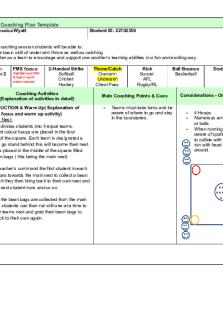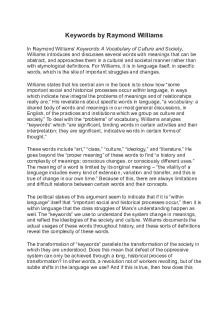Experiment 1-MP-BP - Jessica Williams PDF

| Title | Experiment 1-MP-BP - Jessica Williams |
|---|---|
| Course | Organic Chemistry I Laboratory |
| Institution | University of West Florida |
| Pages | 4 |
| File Size | 362.2 KB |
| File Type | |
| Total Downloads | 5 |
| Total Views | 136 |
Summary
Jessica Williams...
Description
Ex Experi peri perime me ment nt 11:: TThe he Dete Determin rmin rminatio atio ation n of B Boi oi oiling ling Poi Points nts an and dM Meltin eltin eltingg Poi Points nts o off Orga Organic nic C Co ompo mpounds unds BACKGROUND INFORMATION: During this laboratory we will practice As we heat a liquid, the pressure of the vapor above the liquid slowly increases. When this pressure equals the pressure existing in the container, the liquid begins to boil, or turns to vapor. If not contained, the vapor will “escape” into the atmosphere. In other words, the liquid evaporates. If the vapor is contained and passed through an area where the temperature is lower, the vapor will “condense” and enter This process is called . More information on distillation can be found in your lab technique book (3rd edition) on pages 141-157. Atmospheric pressure is approximately 760 mm Hg; i.e., the weight of a column of mercury measuring 1 mm2 and 760 mm tall. This equates to about 29.92 inches of mercury. If we reduce the pressure above the sample that we are heating, we can reduce the boiling point of the liquid. This is referred to as a vacuum distillation or carrying out a distillation in vacuo . For example, water boils at 100 °C (or 212 °F) at 760 mm Hg, but the boiling point drops to around 22 °C when the pressure is reduced to 20 mm Hg.
. Methane, with a mass of 16 g/mol, exhibits only Van der Waals interactions and is a gas at room temperature. Water, with a mass of 18 g/mol, can form hydrogen bonds and boils at 100 °C. While we can often guess the relative boiling points of a related series of compounds, calculating a boiling point based on these factors is difficult. Similarly, the melting point of a compound is a physical property that we can guess, although we cannot predict it on theoretical grounds. Generally speaking, increases in both polarity and molar mass are characterized by increases in melting point as well. To determine the melting point of a compound, we simply very small “test tube” — —and We can see it begin to melt as liquid is observed, and when the melting is completed, and only liquid is visible, we report a melting point range. e, no more than 3 °C, while , often 6-10 °C or more. By comparing the melting range of a sample to those in a list presented in a text or reference book, we can often make a case that we know the identity of an unknown compound. If possible, we then try a “mixture melting point” to gather more data. Let us assume that we have an unknown which melts at 120-122 °C. Let us assume that we also know that it is an acid. From a text, we might guess that our sample is benzoic acid, which has a reported melting point (or melting range) of 121-122 °C. To test the hypothesis, we can take a small amount of our unknown and mix it thoroughly with some authentic benzoic acid that we have obtained from a different source. If we have mixed benzoic acid with benzoic acid, the sample remains pure, and the melting point of the “mixture” will be the same as either sample: 120-122 °C. But if our sample was not benzoic acid, then we have contaminated the authentic benzoic acid with our sample (or contaminated our sample with benzoic acid), and the melting point will be lower and broader, perhaps 95-110 °C. More information on melting point analysis can be found in your lab technique book (3rd edition) on pages 49-53.
THE NATURE OF THE INVESTIGATION: Boiling Point: You will (3rd edition). Two important things to remember are that water always goes into the condenser at the lower nozzle and exits from the higher nozzle (it wouldn’t fill up if you set it up backwards), and . If it is higher, vapors will simply pass below the thermometer bulb without transferring energy to the bulb. This condition would not warm up the thermometer bulb. If the bulb is too low, then hot liquid splashes on the bulb and your reading will be in error. Have the instructor or the teaching assistant verify that you are correctly set up.
Using the sample assignment found below, . The sample is introduced into a 50 mL round- bottomed flask (the distilling flask) along with 1-2 “boiling chips”. Start the flow of cooling water and then apply heat by turning the knob on the . A setting of 3-4 is likely to be appropriate for today’s experiment. Allow the distillation to continue until the system comes to equilibrium. At this point, and remain constant for a considerable period of time. This is the boiling point or boiling range that you should report. If the boiling point suddenly changes, either upward or downward, turn off the heat and cease the distillation. Weigh the isolated product. in terms of volumes, and the boiling point. For example, if you started with 24 mL and collected 18 mL of distilled product, you would have a 75% recovery. From the list below, select the most likely compound for your unknown. Report the experimentally determined density of your compound.
Compound Boiling Point (°C) Density (g/mL)
Methyl t-butyl ether 55 0.741
Methyl ethyl ketone 79 0.805
1-Propanol
1-Butanol
Isoamyl Alcohol
97 0.805
118 0.775
131 0.810
Melting Points: Using the unknown assignments below, determine the melting point of your sample. . Report the pure melting point of your material along with the composition and melting point of each mixture in your laboratory notebook. Compound Literature Melting Point (°C)
Methyl mnitrobenzoate
Naphthalene
Acetanilide
Benzoic acid
Cinnamic acid
78
80-82
114
121-122
133-134
Unknown Sample Assignments Sample A B C D E
1 2 3 4 5
Workstation Number 6 11 7 12 8 13 9 14 10 15
16 17 18 19 20
Graded Items: Pre-lab -
Title, aim, brief procedure, list chemicals and their hazards, disposal and personal protection
Data Sheet -
(5 points)
(25 points)
Be sure to show all calculations
Technique
(20 points)
Data Sheet Experiment # 1 Last Name __________________________________First Name__________________________________________ Boiling Point Unknown Number ______ _________Boiling Point _______________________ Density ______________________
Temp
Identity of Unknown Liquid __________________________________ Percent Recovery ______________________
Time Melting Point Unknown Number ______________________________Melting Point ____________________________________ Melting Point of _____________________+ Unknown Solid : ____________________________________________ Melting Point of _____________________+ Unknown Solid : ____________________________________________ Melting Point of _____________________+ Unknown Solid : ____________________________________________ Identity of Unknown Solid ________________________________________________________________________...
Similar Free PDFs

Portafolio ITB-convertido Jessica
- 12 Pages

Jessica WU - OB scenario
- 1 Pages

Reflexión Jessica Gómez 3PDF
- 1 Pages

Peer coaching plan jessica
- 5 Pages

CASO Williams
- 2 Pages

Jessica Method (1)
- 82 Pages

OB SR Jennifer Jessica Jenny
- 15 Pages

Ejercicios de Williams
- 5 Pages

Keywords by Raymond Williams
- 2 Pages

Williams on equality
- 5 Pages

Texto DE Raymond Williams
- 8 Pages

Robin Williams - Research Paper
- 3 Pages
Popular Institutions
- Tinajero National High School - Annex
- Politeknik Caltex Riau
- Yokohama City University
- SGT University
- University of Al-Qadisiyah
- Divine Word College of Vigan
- Techniek College Rotterdam
- Universidade de Santiago
- Universiti Teknologi MARA Cawangan Johor Kampus Pasir Gudang
- Poltekkes Kemenkes Yogyakarta
- Baguio City National High School
- Colegio san marcos
- preparatoria uno
- Centro de Bachillerato Tecnológico Industrial y de Servicios No. 107
- Dalian Maritime University
- Quang Trung Secondary School
- Colegio Tecnológico en Informática
- Corporación Regional de Educación Superior
- Grupo CEDVA
- Dar Al Uloom University
- Centro de Estudios Preuniversitarios de la Universidad Nacional de Ingeniería
- 上智大学
- Aakash International School, Nuna Majara
- San Felipe Neri Catholic School
- Kang Chiao International School - New Taipei City
- Misamis Occidental National High School
- Institución Educativa Escuela Normal Juan Ladrilleros
- Kolehiyo ng Pantukan
- Batanes State College
- Instituto Continental
- Sekolah Menengah Kejuruan Kesehatan Kaltara (Tarakan)
- Colegio de La Inmaculada Concepcion - Cebu



